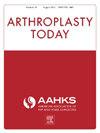Body Mass Index as a Risk Factor for Readmission Rates in Direct Anterior Approach Total Hip Arthroplasty
IF 1.5
Q3 ORTHOPEDICS
引用次数: 0
Abstract
Background
Multiple studies have examined the relationship between obesity and increased risk of perioperative complications in patients undergoing total hip arthroplasty (THA). The purpose of this study was to compare the rate of perioperative complications stratified by body mass index (BMI) in patients undergoing THA through a direct anterior (DA) approach.
Methods
A retrospective review at a single high-volume orthopaedic specialty hospital identified all DA THAs performed between January 2019 and August 2022. Patients were stratified by BMI into the following cohorts: underweight (BMI<18.5), normal (BMI = 18.5-25), overweight (BMI = 25-30), obese class I (BMI = 30-35), obese class II (BMI = 35-39.9), and obese class III (BMI ≥ 40). Primary outcomes collected included 30-day and 90-day readmissions, emergency department visits, intraoperative fracture, and 90-day infection requiring return to the operating room. There were 4767 patients with a mean BMI of 28 kg/m2 (15.5-54.5) and a mean age of 67 years (18-100 years).
Results
Thirty-day readmission rates in the obese class III (6.2%) were significantly higher when compared individually to all other cohorts (P < .001). Additionally, logistic regression found that underweight patients had an increased likelihood of an intraoperative fracture (odds ratio [OR]: 13.120, 95% confidence interval [CI]: 1.172-146.930, P < .001), and both obese classes I and III were more likely to have a 90-day infection that required a return to the operating room (OR: 8.508, 95% CI: 1.023-70.779, P < .001 and OR: 29.853, 95% CI: 2.683-332.187, P < .001, respectively).
Conclusions
Obese class III patients have a higher rate of 30-day readmission following DA THA than all other BMI cohorts and are at increased risk of infection requiring return to the operating room when compared to patients with normal BMI. Surgeons should counsel patients regarding the increased potential complication risks related to BMI.
求助全文
约1分钟内获得全文
求助全文
来源期刊

Arthroplasty Today
Medicine-Surgery
CiteScore
2.90
自引率
0.00%
发文量
258
审稿时长
40 weeks
期刊介绍:
Arthroplasty Today is a companion journal to the Journal of Arthroplasty. The journal Arthroplasty Today brings together the clinical and scientific foundations for joint replacement of the hip and knee in an open-access, online format. Arthroplasty Today solicits manuscripts of the highest quality from all areas of scientific endeavor that relate to joint replacement or the treatment of its complications, including those dealing with patient outcomes, economic and policy issues, prosthetic design, biomechanics, biomaterials, and biologic response to arthroplasty. The journal focuses on case reports. It is the purpose of Arthroplasty Today to present material to practicing orthopaedic surgeons that will keep them abreast of developments in the field, prove useful in the care of patients, and aid in understanding the scientific foundation of this subspecialty area of joint replacement. The international members of the Editorial Board provide a worldwide perspective for the journal''s area of interest. Their participation ensures that each issue of Arthroplasty Today provides the reader with timely, peer-reviewed articles of the highest quality.
 求助内容:
求助内容: 应助结果提醒方式:
应助结果提醒方式:


